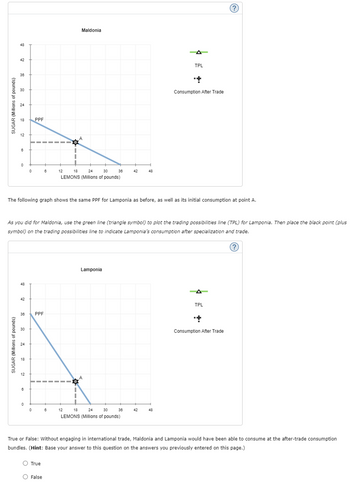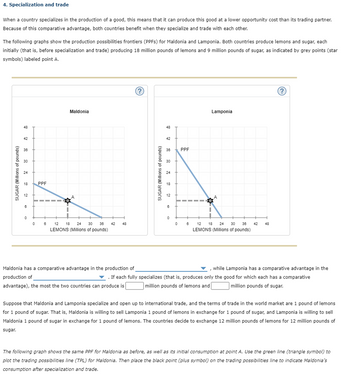
ENGR.ECONOMIC ANALYSIS
14th Edition
ISBN: 9780190931919
Author: NEWNAN
Publisher: Oxford University Press
expand_more
expand_more
format_list_bulleted
Question

Transcribed Image Text:SUGAR (Millions of pounds)
48
42
SUGAR (Millions of pounds)
36
30
24
18 PPF
12
6
0
48
42
36 PPF
30
24
18
0
12
8
0
The following graph shows the same PPF for Lamponia as before, as well as its initial consumption at point A.
As you did for Maldonia, use the green line (triangle symbol) to plot the trading possibilities line (TPL) for Lamponia. Then place the black point (plus
symbol) on the trading possibilities line to indicate Lamponia's consumption after specialization and trade.
(?)
0
6
True
O False
12
18
24
30
LEMONS (Millions of pounds)
6
Maldonia
12
36
Lamponia
42
18 24 30
LEMONS (Millions of pounds)
36
48
42
TPL
++
48
Consumption After Trade
(?)
TPL
Consumption After Trade
True or False: Without engaging in international trade, Maldonia and Lamponia would have been able to consume at the after-trade consumption
bundles. (Hint: Base your answer to this question on the answers you previously entered on this page.)

Transcribed Image Text:4. Specialization and trade
When a country specializes in the production of a good, this means that it can produce this good at a lower opportunity cost than its trading partner.
Because of this comparative advantage, both countries benefit when they specialize and trade with each other.
The following graphs show the production possibilities frontiers (PPFS) for Maldonia and Lamponia. Both countries produce lemons and sugar, each
initially (that is, before specialization and trade) producing 18 million pounds of lemons and 9 million pounds of sugar, as indicated by grey points (star
symbols) labeled point A.
SUGAR (Millions of pounds)
48
42
38
30
24
18 PPF
12
8
0
0
8
1
Maldonia
12 18 24 30 36
LEMONS (Millions of pounds)
42 48
?
Maldonia has a comparative advantage in the production of
production of
advantage), the most the two countries can produce is
SUGAR (Millions of pounds)
48
42
36
30
24
18
12
6
0
0
PPF
6
Lamponia
A
12 18 24 30 36 42 48
LEMONS (Millions of pounds)
?
, while Lamponia has a comparative advantage in the
▼. If each fully specializes (that is, produces only the good for which each has a comparative
million pounds of lemons and
million pounds of sugar.
Suppose that Maldonia and Lamponia specialize and open up to international trade, and the terms of trade in the world market are 1 pound of lemons
for 1 pound of sugar. That is, Maldonia is willing to sell Lamponia 1 pound of lemons in exchange for 1 pound of sugar, and Lamponia is willing to sell
Maldonia 1 pound of sugar in exchange for 1 pound of lemons. The countries decide to exchange 12 million pounds of lemons for 12 million pounds of
sugar.
The following graph shows the same PPF for Maldonia as before, as well as its initial consumption at point A. Use the green line (triangle symbol) to
plot the trading possibilities line (TPL) for Maldonia. Then place the black point (plus symbol) on the trading possibilities line to indicate Maldonia's
consumption after specialization and trade.
Expert Solution
This question has been solved!
Explore an expertly crafted, step-by-step solution for a thorough understanding of key concepts.
This is a popular solution
Trending nowThis is a popular solution!
Step by stepSolved in 3 steps with 2 images

Knowledge Booster
Learn more about
Need a deep-dive on the concept behind this application? Look no further. Learn more about this topic, economics and related others by exploring similar questions and additional content below.Similar questions
- What is the per-unit opportunity cost of product Y as production moves from point B to point F? a) -4/3 b) 4/3 c) ¾ d) -¾ e) none of the abovearrow_forwardSuppose the fictional country of Everglades produces only two goods: sorghum and telephoto lenses. The following graph plots Everglades's current production possibilities frontier, and includes six different output combinations given by black points (plus symbols) labeled A to F. 80 PPF 60 K E + 40 20 A B C D 100 TELEPHOTO LENSES (Millions) Point Inefficient E F 0 0 ++ Complete the following table by indicating whether each point represents output combinations that are inefficient, efficient, or unattainable. Check all that apply. 0 C r 20 0 60 SORGHUM (Millions of bushels) Efficient 00 0 40 0 X8 C D Unattainable 0 0 00 80 100arrow_forwardMitchell and Scott can produce either apples or oranges. The table lists the maximum number of each that they can produce per day. Apples Oranges Mitchell 6 30 Scott 12 24 Which of the following combinations of goods is it possible for Mitchell and Scott to consume if they can trade apples and oranges on the world market at a price of $6/kg for apples and $1/kg for oranges? 15kg of apples and 18kg of oranges 15kg of apples and 20kg of oranges 10kg of apples and 50kg of oranges Okg of apples and 108kg of orangesarrow_forward
- QUESTION 19 Exhibit: Production Possibilities in Alphaland and Omegaland Computers (thousands per year) 2947654321 10 (Exhibit: for O a. 1; 2 Ob. 2; 1 O c. 1; 1/5 O d. 1/5; 1 Panel (A) Alphaland (Slope of PPC at A = -2) Cars (thousands per year) Computers (thousands per year) 10 9 8 Panel (B) Omegaland (Slope of PPC at A' = -0.2) A' Cars (thousands per year) 11 Production Possibilities in Alphaland and Omegaland) Before trade in Omegaland, computer. car could exchangearrow_forwardSuppose that research finds a link between high fructose corn syrup (HFCS) and obesity, which then leads American consumers to switch from HFCS products to pure cane sugar products. The graphs show the markets for cane sugar in Haiti and the United States before the studies were divulged. Shift the curves in the graphs, including the horizontal world price curve, to describe the new trade equilibrium that results after the switch in preferences of American households, and then answer the follow‑up question. Assume that the United States and Haiti are the only non‑HFCS sugar trading parties in the world and that there are no quotas, subsidies, or tariffs distorting these markets. According to your graphs, at the new equilibrium a. all Haitian cane sugar consumers benefit. b. cane sugar producers in Haiti benefit. d. cane sugar producers in the United States are worse off.arrow_forwardBeer 10 0 10 20 30 Pizza West Lothian Beer 20 1319 10 0 10 20 30 Pizza East Lothian In the accompanying diagrams, solid lines are production possibilities curves, and the dashed lines are trading possibilities curves. The data contained in the production possibilities curves are based on the assumption ofarrow_forward
- Is The combination of 30 pounds of coffee beans and 12 pounds of nuts per day unattainable, attainable and efficient or attainable and inefficient Provided to plot Krisha and Tom's PPC. Plot three points total: one point if they both pick only coffee beans, a second point if they both completely specialize according to their respective comparative advantage, and a third if both gather only nuts.arrow_forwardWhen a country has a comparative advantage in the production of a good, it means that it can produce this good at a lower opportunity cost than its trading partner. Then the country will specialize in the production of this good and trade it for other goods. The following graphs show the production possibilities frontiers (PPFS) for Freedonia and Desonia. Both countries produce grain and tea, each initially (i.e., before specialization and trade) producing 6 million pounds of grain and 3 million pounds of tea, as indicated by the grey stars marked with the letter A. TEA (Millions of pounds) tea. 16 14 12 10 8 6 2 0 0 PPF 2 Freedonia Þ 4 6 8 10 12 GRAIN (Millions of pounds) 14 16 ? TEA (Millions of pounds) 16 14 Note: Dashed drop lines will automatically extend to both axes. 12 10 6 2 0 0 PPF I 2 Desonia 4 6 8 10 12 GRAIN (Millions of pounds) 7 Freedonia has a comparative advantage in the production of while Desonia has a comparative advantage in the production of ▼. Suppose that…arrow_forwardX 10:32 = X Figure 2-3 Tomatoes Graph A B Strawberries A Graph A Graph B C) Graph C Blackboard Tomatoes Assignment Refer to Figure 2-3. Carlos Vanya grows tomatoes and strawberries on his land. A portion of his land is more suitable for growing tomatoes and the other portion is better suited for strawberry cultivation. Which of the graphs in Figure 2-3 represent his production possibilities frontier? Graph B Questions Filter (20) ◄ Save and Close Strawberries D either Graph A or Graph B Tomatoes Last saved 10:20:10 PM Graph C Submit Strawberriesarrow_forward
arrow_back_ios
SEE MORE QUESTIONS
arrow_forward_ios
Recommended textbooks for you

 Principles of Economics (12th Edition)EconomicsISBN:9780134078779Author:Karl E. Case, Ray C. Fair, Sharon E. OsterPublisher:PEARSON
Principles of Economics (12th Edition)EconomicsISBN:9780134078779Author:Karl E. Case, Ray C. Fair, Sharon E. OsterPublisher:PEARSON Engineering Economy (17th Edition)EconomicsISBN:9780134870069Author:William G. Sullivan, Elin M. Wicks, C. Patrick KoellingPublisher:PEARSON
Engineering Economy (17th Edition)EconomicsISBN:9780134870069Author:William G. Sullivan, Elin M. Wicks, C. Patrick KoellingPublisher:PEARSON Principles of Economics (MindTap Course List)EconomicsISBN:9781305585126Author:N. Gregory MankiwPublisher:Cengage Learning
Principles of Economics (MindTap Course List)EconomicsISBN:9781305585126Author:N. Gregory MankiwPublisher:Cengage Learning Managerial Economics: A Problem Solving ApproachEconomicsISBN:9781337106665Author:Luke M. Froeb, Brian T. McCann, Michael R. Ward, Mike ShorPublisher:Cengage Learning
Managerial Economics: A Problem Solving ApproachEconomicsISBN:9781337106665Author:Luke M. Froeb, Brian T. McCann, Michael R. Ward, Mike ShorPublisher:Cengage Learning Managerial Economics & Business Strategy (Mcgraw-...EconomicsISBN:9781259290619Author:Michael Baye, Jeff PrincePublisher:McGraw-Hill Education
Managerial Economics & Business Strategy (Mcgraw-...EconomicsISBN:9781259290619Author:Michael Baye, Jeff PrincePublisher:McGraw-Hill Education


Principles of Economics (12th Edition)
Economics
ISBN:9780134078779
Author:Karl E. Case, Ray C. Fair, Sharon E. Oster
Publisher:PEARSON

Engineering Economy (17th Edition)
Economics
ISBN:9780134870069
Author:William G. Sullivan, Elin M. Wicks, C. Patrick Koelling
Publisher:PEARSON

Principles of Economics (MindTap Course List)
Economics
ISBN:9781305585126
Author:N. Gregory Mankiw
Publisher:Cengage Learning

Managerial Economics: A Problem Solving Approach
Economics
ISBN:9781337106665
Author:Luke M. Froeb, Brian T. McCann, Michael R. Ward, Mike Shor
Publisher:Cengage Learning

Managerial Economics & Business Strategy (Mcgraw-...
Economics
ISBN:9781259290619
Author:Michael Baye, Jeff Prince
Publisher:McGraw-Hill Education